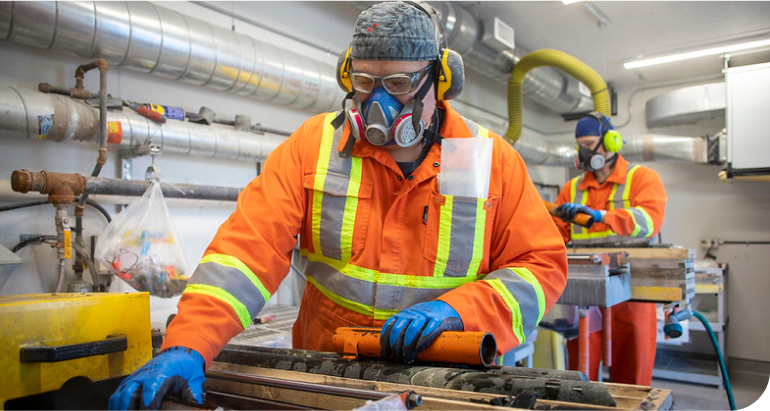Heavy Industry
Index Score
Thematic Breakdown
Policy Score
Policy Score
Progress was mostly driven by the federal benchmark carbon price bump, with additional support from the rollout of provincial industrial decarbonization programs and legislation of key incentives such as the CCUS investment tax credit.
Detailed Scorecard
Indexed to 2019
baseline year
Weighted contribution to heavy industry sector score
Capital Score
Capital Score
A drop in private investment flows to decarbonize Canada’s heavy industries fell, amid a broader slowdown in climate-related venture capital, saw the capital score dropEndnote 5. These investments had driven the capital score higher in 2022 and 2023. However, government subsidies continue to contribute positively to the overall score.
Detailed Scorecard
Indexed to 2019
baseline year
Weighted contribution to heavy industry sector score
Action Score
Action Score
The continued use of natural gas in industries such as iron and steel, and cement, has kept the sector score flat over the past three years.
Detailed Scorecard
Indexed to 2019
baseline year
Weighted contribution to heavy industry sector score
Emissions Score
Emissions Score
Absolute emissions and emissions intensity relative to GDP were largely unchanged over the past few years, leaving the index flatEndnote 6.
Detailed Scorecard
Indexed to 2019
baseline year
Weighted contribution to heavy industry sector score
Historical Trends
Policy:
Capital:
Consumer Action:
Emissions:
Business Action:
Technology:
Total:
Policy:
Capital:
Consumer Action:
Emissions:
Business Action:
Technology:
Total:
Policy:
Capital:
Consumer Action:
Emissions:
Business Action:
Technology:
Total:
Policy:
Capital:
Consumer Action:
Emissions:
Business Action:
Technology:
Total:
Policy:
Capital:
Consumer Action:
Emissions:
Business Action:
Technology:
Total:
Policy:
Capital:
Consumer Action:
Emissions:
Business Action:
Technology:
Total:


CASE STUDYEndnote 7
Canada Nickel: The low emissions mining model
The Issue
Critical minerals such as nickel, lithium and cobalt are vital for the acceleration of energy transition. But their extraction is a carbon-intensive process, which could become especially problematic as the world quadruples mineral production for clean energy technologies by 2040, according to International Energy Agency projections.
Mining also accounts for 2% of Canada’s emissions and 15% of the country’s heavy industry footprint. With the Canadian government eager to tap the country’s vast mineral resources to build electric vehicle batteries, solar panels and wind turbines, industry players are exploring innovative ways to develop new mines without adding to Canada’s carbon footprint.
The Company
Founded in 2019, Canada Nickel is a relatively small Toronto-based mining company. Its flagship Crawford Nickel-Sulphide Project, in northern Ontario, is one of the world’s biggest nickel projects under way, with an estimated production of 1.6 million tonnes nickel and 24,000 tonnes of cobalt over its life. Currently under regulatory review, the $3.5 billion project in the Timmins region could potentially begin in 2027, extending Canada’s reputation as a budding hub for the EV supply chain.
The company had to make a call very early during its inception in 2019: should it build a low-carbon company from the outset, or focus on mining nickel, seeing it as critical to decarbonization? It chose the harder, more expensive route of building a “net negative carbon” company that would power electric vehicles.


The Technology
“Ultramafic” rocks, which naturally absorb and sequester carbon, did some of the heavy lifting for the company’s “net-zero” model. (Canada Nickel holds NetZero Nickel, NetZero Cobalt and NetZero Iron trademarks across several jurisdictions).
But to help nature along, Canada Nickel developed a proprietary In-Process Tailings (IPT) carbonation, which involves injecting CO2 into tailings generated by ore milling. The tailings could be one of Canada’s largest carbon storage facilities, with 1.3 million tonnes of carbon storage annually—roughly 12% of Canada’s mining emissions.
The Opportunity
North America’s hopes for expanded nickel production rests on Canada’s nickel reserves—the seventh largest in the world—to make battery grade nickel sulfate that power electric vehicle batteries. In addition, “net zero nickel” could give Canada a competitive edge in a world of rising environmental trade tariffs such as the EU’s Carbon Border Adjustment Mechanism. Canada Nickel aims to capture that opportunity, and leverage Crawford to spawn a low-carbon industry in the emerging Timmins-Cochrane mining district, with refining capacity of 80,000 of tonnes of nickel for third parties and storage capacity of 20 million tonnes annually.
The Unlock
Eager to cut their own Scope 3 emissions, deep-pocketed institutions have come calling: Agnico Eagle (with an 11% stake in Canada Nickel), Samsung SDI (8.7%) and Anglo American (7.6%) are early investors, while Export Development Canada has expressed an interest in providing long-term debt loan of up to US$500 million. In addition, Canada Nickel aims to tap the federal government’s refundable tax credits for carbon capture.
Licensing the technology to other producers, especially those in iron- and magnesium-rich rocks that can store CO2 in their mine tailings, can further create a decarbonizing ripple effect cascading across the wider industry.
But Canada Nickel’s “net-zero” math partially depends on Ontario’s grid. The province’s low-carbon electricity, generated through nuclear and hydro facilities, has allowed the junior miner to plan with clean power at its heart.
The company has also deployed electric shovels and trolley-assisted haul trucks to minimize diesel use, and ensure its operations remain low-carbon independent of the provincial grid’s energy mix. The company’s direct emissions fell 76% from 2023 to 2022, as it cut diesel gasoline and jet fuel consumption.
The low-carbon footprint, combined with 50 tonnes of CO2 storage for every tonne of nickel produced, would make Canada Nickel one of the world’s cleanest suppliers of critical minerals.
The Lesson
Sustainability is now a competitive advantage in the carbon-intensive mining sector. Canada Nickel’s early decisions to embed carbon capture technology in its business model attracted institutional investors with offtake agreements. It also allowed the company to tap the government’s green subsidies and incentives, bringing much-needed financial certainty and flexibility to the project.


Investors are looking for novel ways to help solve the carbon issue for the planet. Having a negative carbon footprint mining operation is pretty unique, globally.
Mark Selby,
CEO, Canada Nickel






